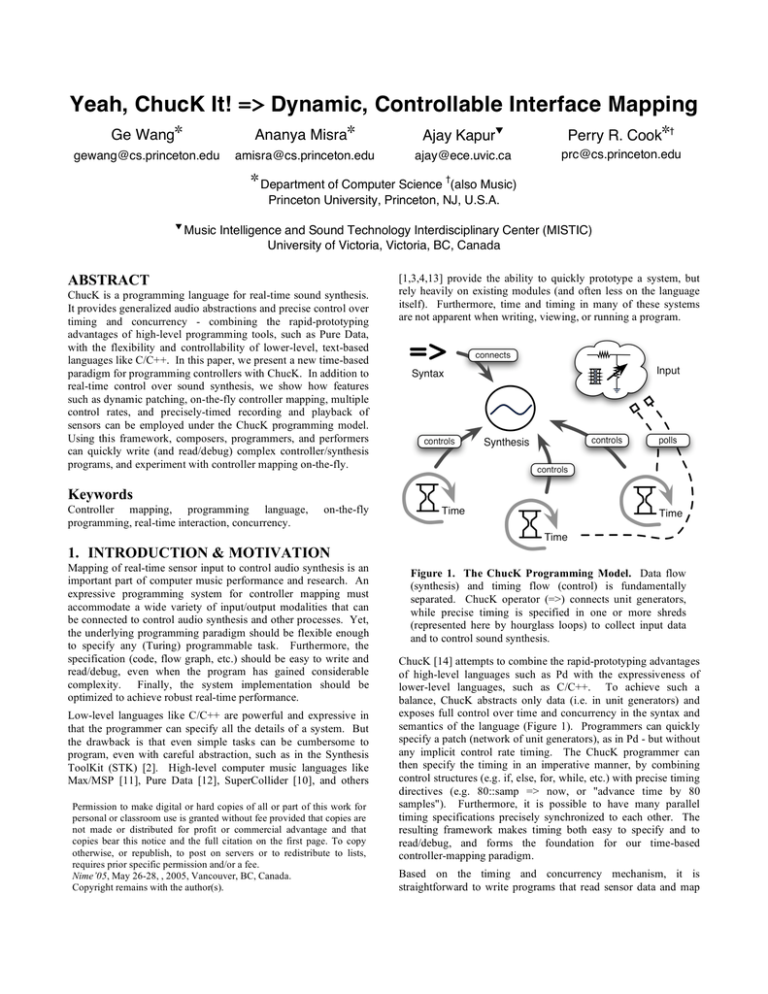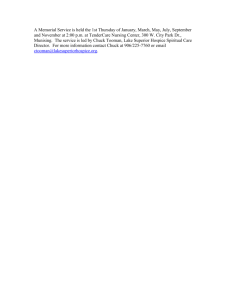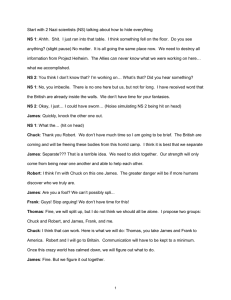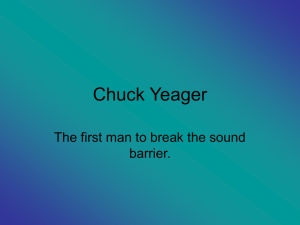=> Dynamic, Controllable Interface Mapping Yeah, ChucK It! Ge Wang
advertisement

Yeah, ChucK It! => Dynamic, Controllable Interface Mapping
Ge Wang
Ananya Misra
Ajay Kapur
Perry R. Cook†
gewang@cs.princeton.edu
amisra@cs.princeton.edu
ajay@ece.uvic.ca
prc@cs.princeton.edu
†
Department of Computer Science (also Music)
Princeton University, Princeton, NJ, U.S.A.
Music Intelligence and Sound Technology Interdisciplinary Center (MISTIC)
University of Victoria, Victoria, BC, Canada
ABSTRACT
ChucK is a programming language for real-time sound synthesis.
It provides generalized audio abstractions and precise control over
timing and concurrency - combining the rapid-prototyping
advantages of high-level programming tools, such as Pure Data,
with the flexibility and controllability of lower-level, text-based
languages like C/C++. In this paper, we present a new time-based
paradigm for programming controllers with ChucK. In addition to
real-time control over sound synthesis, we show how features
such as dynamic patching, on-the-fly controller mapping, multiple
control rates, and precisely-timed recording and playback of
sensors can be employed under the ChucK programming model.
Using this framework, composers, programmers, and performers
can quickly write (and read/debug) complex controller/synthesis
programs, and experiment with controller mapping on-the-fly.
[1,3,4,13] provide the ability to quickly prototype a system, but
rely heavily on existing modules (and often less on the language
itself). Furthermore, time and timing in many of these systems
are not apparent when writing, viewing, or running a program.
Keywords
Controller mapping, programming language,
programming, real-time interaction, concurrency.
on-the-fly
1. INTRODUCTION & MOTIVATION
Mapping of real-time sensor input to control audio synthesis is an
important part of computer music performance and research. An
expressive programming system for controller mapping must
accommodate a wide variety of input/output modalities that can
be connected to control audio synthesis and other processes. Yet,
the underlying programming paradigm should be flexible enough
to specify any (Turing) programmable task. Furthermore, the
specification (code, flow graph, etc.) should be easy to write and
read/debug, even when the program has gained considerable
complexity. Finally, the system implementation should be
optimized to achieve robust real-time performance.
Low-level languages like C/C++ are powerful and expressive in
that the programmer can specify all the details of a system. But
the drawback is that even simple tasks can be cumbersome to
program, even with careful abstraction, such as in the Synthesis
ToolKit (STK) [2]. High-level computer music languages like
Max/MSP [11], Pure Data [12], SuperCollider [10], and others
Permission to make digital or hard copies of all or part of this work for
personal or classroom use is granted without fee provided that copies are
not made or distributed for profit or commercial advantage and that
copies bear this notice and the full citation on the first page. To copy
otherwise, or republish, to post on servers or to redistribute to lists,
requires prior specific permission and/or a fee.
Nime’05, May 26-28, , 2005, Vancouver, BC, Canada.
Copyright remains with the author(s).
Figure 1. The ChucK Programming Model. Data flow
(synthesis) and timing flow (control) is fundamentally
separated. ChucK operator (=>) connects unit generators,
while precise timing is specified in one or more shreds
(represented here by hourglass loops) to collect input data
and to control sound synthesis.
ChucK [14] attempts to combine the rapid-prototyping advantages
of high-level languages such as Pd with the expressiveness of
lower-level languages, such as C/C++. To achieve such a
balance, ChucK abstracts only data (i.e. in unit generators) and
exposes full control over time and concurrency in the syntax and
semantics of the language (Figure 1). Programmers can quickly
specify a patch (network of unit generators), as in Pd - but without
any implicit control rate timing. The ChucK programmer can
then specify the timing in an imperative manner, by combining
control structures (e.g. if, else, for, while, etc.) with precise timing
directives (e.g. 80::samp => now, or "advance time by 80
samples"). Furthermore, it is possible to have many parallel
timing specifications precisely synchronized to each other. The
resulting framework makes timing both easy to specify and to
read/debug, and forms the foundation for our time-based
controller-mapping paradigm.
Based on the timing and concurrency mechanism, it is
straightforward to write programs that read sensor data and map
them to sound synthesis parameters. Input-polling and event
synchronization can be placed at any point in time. Control rate
can be dynamically specified (or computed) for each sensor (e.g.
FSR’s every 5 milliseconds, accelerometers every 50
milliseconds, temperature sensors every 30 seconds).
Concurrency allows for any number of sensors to be handled
separately in an organized and scalable manner.
A sound synthesis patch can be quickly constructed by connecting
unit generators, using the ChucK operator (=>). Line 1 (Figure 2)
sets up such a patch by connecting a sine oscillator to a
reverberator, which is connected to the digital/analog converter.
All patches deal only with audio data and have no notion of time
or control. This is advantageous because it reserves the ability to
specify timing to the programmer.
The remainder of this paper is organized as follows. Section 2
describes the basics of using ChucK to map sensors to control
sound synthesis. Section 3 covers some advanced features, such
as dynamic/on-the-fly patching, dynamic voice allocation,
concurrent sensor mapping, and recording + playback of sensor
data. Section 4 describes some case studies for controller
mapping with ChucK. Finally, we discuss future work and
conclude in Section 5.
Timing information is specified in time loops, such as the one on
lines 10-33. We can specify any arbitrary timing pattern by
advancing time appropriately. Line 13 in the example shows time
being advanced by 5 milliseconds. Control over the unit
generators is interlaced with timing, allowing the programmer to
manipulate them at any time with sample-level precision.
2. BASIC MAPPING IN CHUCK
The ChucK framework makes it easy to write a program that
maps controller input to sound synthesis. The syntax has been
described extensively in previous works [14-16]. In this section,
we present simple examples that illustrate basic tasks such as
mapping MIDI input to synthesis parameters, using both polling
as well as non-polling, event-based techniques. Although the
examples focus on MIDI input, the framework can be easily
modified for other standards (e.g. network I/O, serial I/O, and
Open Sound Control [17]), sensors, as well as new algorithms for
sound synthesis.
2.1 A Simple Polling Example
The mapping process can be divided into two components: setting
up a synthesis patch, and specifying the timing information for
controlling it.
01#
02#
03#
04#
05#
06#
07#
08#
09#
10#
11#
12#
13#
14#
15#
16#
17#
18#
19#
20#
21#
22#
23#
24#
25#
26#
27#
28#
29#
30#
31#
32#
33#
// the patch: sine wave to reverberator to dac
sinosc s => JCRev r => dac;
// initial settings
.2 => r.mix;
// declare a MIDI message to be filled in
MidiMsg msg;
// infinite time-loop
while( true )
{
// advance time (by 5 milliseconds)
5::ms => now;
// poll MIDI – (could be any event)
while( midi.in( msg ) )
{
// if the message was a note on
if( msg.type == midi.NOTE_ON )
{
// convert to frequency, and set
std.mtof( msg.data1 ) => s.sfreq;
// set gain of sinosc
msg.data2 / 128.0 => s.gain;
}
else if( type == midi.KNOB )
{
// set dry/wet mix and gain of reverb
midi.data1 / 128.0 => float mix => r.mix;
.25 + .25 * (1.0-mix) => r.gain;
}
}
}
Figure 2. A simple skeleton framework for polling input to
control sound synthesis.
Next, we can collect controller information – in this case, by
polling. In our example, MIDI is polled (line 16) for input
whenever time is advanced. Because we can specify arbitrary
timing patterns and poll for input at any point, the timing pattern
implicitly becomes the control rate for the sensor. This gives the
programmer the ability to adapt code to poll different sensors at
different control rates as needed. For instance, (as mentioned
earlier) the ideal control rate for a force-sensing resistor is on the
order of milliseconds, whereas a temperature-based sensor may
need to be polled every few seconds or minutes.
Once we have obtained control data from polling, we can apply
the information immediately or store it for use at some later time.
In the example, the frequency, gain and mix parameters of the
sinosc and JCRev unit generators are changed at once based
on the specific input received (lines 19-31). However, it is
possible to perform a variety of other actions including:
• Dynamically modify the patch by adding or removing unit
generators (discussed in Section 3.1)
• Spork a new process/shred (using the spork ~ operator)
• Spork a shred from file (using machine.add() )
• Clone a shred (with a shred.clone() function)
Furthermore, all the above steps can be carried out concurrently
with multiple processes. In this way, many sensors can be read at
the same time or information from a single sensor can be used by
several processes, through user-defined broadcasts and events (not
shown).
2.2 Alternative to Polling: Events
An alternative to polling is to obtain input data using events.
Events are system or user-defined objects that a ChucK process
can wait on. In this case, time is advanced only when a MIDI
event occurs (line 5) – the event is triggered internally by the I/O
subsystem. The relevant sensor information associated with that
event is passed back via the msg variable, which the process
handles as it deems fit. The final translation of sensor data to
sound is carried out in the same way as before.
01#
02#
03#
04#
05#
06#
07#
08#
09#
// infinite time-loop
while( true )
{
// event (instead of explicitly advancing time)
midi.event( msg ) => now;
// at this point, assume event occurred
// handle msg as desired…
}
Figure 3. The previous example modified to use events
instead of polling.
Events and polling are two methods of achieving the same task. A
programmer would use polling when they want precise control
over input timing. On the other hand, a programmer might use
events in situations where it is appropriate to relinquish some
timing control to the system.
3. ADVANCED FEATURES
In addition to the basic methods to map input to synthesis
parameters, it is also possible to take advantage of some advanced
features as part of the ChucK language. These include dynamic
patching, dynamic voice allocation, concurrent sensor mapping,
and precisely-timed recording + playback of sensor data.
Additionally, it is possible to experiment with these features 'onthe-fly' - without restarting or stopping the virtual machine,
leveraging the on-the-fly programming features of ChucK.
3.1 Dynamic Patching
Dynamic patching refers to constructing and modifying synthesis
patches at runtime [8]. Because the ChucK patching semantics
are inherently dynamic (unit generators can be created, connected,
or disconnected at any point in time), this is simply a consequence
of the language semantics. For example, it is straightforward to
write a program that changes the unit generator graph topology
using input from sensors. It would use a similar framework as the
example in Section 4, but instead of changing unit generator
parameters, operations on the unit generator graph itself can be
performed (Figure 4).
01#
02#
03#
04#
05#
06#
07#
08#
// inserting a new unit generator
if( switch_hit )
{
// disconnect foo from bar w/ 'unchuck' operator
foo =< bar;
// reconnect foo to new Filter to bar
foo => Filter f => bar;
}
(a)
01# // connect/disconnect two unit generator graphs
02# if( toggle ) pa => pb; // connect
03# else
pa =< pb; // disconnect
(b)
Figure 4. Two dynamic patching examples. (a) Inserting
a new unit generator on demand. (b) Connecting and
disconnecting two existing unit generator sub-patches.
For example, Formant Wave Functions (FOFs) can be flexibly
controlled in this manner. The number of FOFs needed at a given
time depends on the length of the FOF and the current pitch. In
ChucK, the programmer can dynamically allocate and delete
FOFs by adding or removing unit generators.
3.2 Dynamic Voice Allocation
Dynamic voice allocation allows for entire synthesis patches to be
incorporated into the global unit generator graph, samplesynchronously, and without pre-allocation. This is useful for
synthesizing polyphony with an arbitrary number of voices. In
order to synthesize polyphony, a separate instance of a synthesis
patch must be allocated for each voice. Some systems have a fixed
maximum number of voices allocated beforehand, which limits
the program during runtime, and potentially incurs unnecessary
memory and CPU overhead.
In ChucK, a new voice is simply given its own process, also
called a shred. A shred can be instantiated on demand and can, in
turn, carry out dynamic patching as described in Section 5.1. New
shreds can be created and assimilated into the virtual machine in
the following ways:
machine.add( “voice.ck” ) => shred id;
// or...
me refers to this process
machine.add( me.clone() ) => shred id;
Figure 5. Dynamic voice allocation can be implemented by
inserting a new shred into the VM, either from file or by
cloning an existing shred.
There is no preset limit to the number of shreds that can be
dynamically instantiated. Shreds/voices can be created and
deleted precisely as needed, without pre-allocation.
3.3 On-the-fly Controller Mapping
While it is possible to write programs before execution, the
features of on-the-fly programming [15] can be employed to
modify and augment the controller mapping logic and parameters
during runtime. For example, new program modules can be
integrated into the virtual machine, introducing new mappings
dynamically without having to restart the system. It is also
possible to replace an existing controller mapping or synthesis
algorithm by swapping existing shred(s) with updated ones in a
sample-synchronous manner. This allows programmers to rapidly
experiment with their controller mapping.
3.4 Precise Recording/Playback
A key ChucK tool for successful mapping is the ability to record
sample-accurate, synchronized audio and gestural data, enabling a
user to record a performance and then playback all the data,
tweaking parameters to obtain desired effects and sound synthesis.
This is made possible by ChucK’s precise access to "now", along
with easy abstraction of control and audio data as arrays of timestamped events. Playback is made easy by iterating through
arrays of recorded data and asserting control at each element, and
advancing time to the next point using the recorded time-stamps.
4. Case Studies
ChucK proves to be a useful tool with off-the-shelf controllers as
well as custom-built instruments. It is easy to have an armada of
synthesis techniques at the touch of a command line, from FM
synthesis, wavetable synthesis, to control of physical models.
ChucK makes it easy to switch between algorithms, manually and
programmatically sporking new processes and removing others.
One fun application is to convert arrays of sliders and knobs (like
those seen on the Edirol PCR series) into a DJ beat station using
ChucK’s inherent timing capabilities.
We also explored with mapping one of the earlier controllers, the
Radio Drum [9]. We were easily able to convert all patches
written for other case studies, having the drum controller
sonifying physical models to FM synthesizers. A successful
mapping with the Radio Drum controlled digital audio effect
parameters in 3D space, such as reverb and pitch shifters.
Our next experiments used ChucK with Indian drum controllers,
the ETabla [5] and Edholak [7]. The ETabla mapped physical
models of the tabla [5], which are now ported to ChucK and work
well in real time. We also developed a system for high-level
feature extraction of input data. This allowed the performer to tap
a beat, and ChucK would record the incited rhythm with a chosen
sample or sequence, loop it, transform it, and spork a new process
when another rhythm was performed.
Experiments with the ESitar controller [6] using ChucK opened
many new avenues for experimentation. As described in [6], the
controller takes both the natural audio signal from the traditional
instrument as well as control data from a variety of sensors and
uses both streams to process and synthesize sound. Using ChucK
program modules, we recorded synchronized audio and controller
input and then played back the streams in ChucK to tweak
parameters on-the-fly in the mapping algorithms until the desired
effect was obtained. Experiments with comb-filters, delay lines,
ring modulation, and controlling moog synthesizers all proved to
be successful and straightforward to implement and control.
With ChucK in conjunction with environments like the Audicle
[16], we hope to provide a full platform for performance and
experimentation with controllers, synthesis, and live code.
6. ACKNOWLEDGMENTS
We would like to thank the growing ChucK community for their
ideas, discussions, sample programs, and overall support. Special
thanks to Adam R. Tindale for his support, ideas, and
implementation for this paper. Also thanks to Trimpin for the use
of his robotic turntable for experimentation with ChucK.
http://chuck.cs.princeton.edu/
REFERENCES
[1] Boulanger, R. The C Sound Book. The MIT Press, 2000.
[2] Cook, P.R. and G. Scavone. “The Synthesis ToolKit (STK),” In
[3]
[4]
[5]
[6]
[7]
Figure 6. ESitar controller using ChucK to communicate
with Trimpin’s eight robotic turntables.
An exciting experiment was to use ChucK to communicate with
Trimpin’s eight robotic turntables using the ESitar controller
(Figure 6). Trimpin’s turntables accept MIDI input, and control
motors to turn on, turn off, reverse, forward, speed up, or slow
down the record. ChucK made it simple to map gesture/sensor
input from the ESitar to the turntables, and to do the robotics
programming on-the-fly.
5. CONCLUSION AND FUTURE WORK
We have presented a time-based programming paradigm for
mapping interfaces. The primary advantages of this approach are
that timing is easy to specify and that the mapping itself is highly
controllable. Under this framework, it is straightforward to
perform tasks such as dynamic patching, dynamic voice allocation
and recording/playback of synchronized audio + control data. We
have also described both a polling and an event-based method for
gathering input data in real-time. We performed experiments on a
variety of musical interfaces (which have all survived).
There are many areas for improvement. For example, due to the
sample-synchronous architecture of ChucK, it inherently incurs
more overhead than frame-based systems, such as Pd, Max/MSP.
This sacrifice has enabled ChucK to achieve a different manner of
flexibility. However, optimizations to improve system
performance are desired. Other future work includes allowing
programmers to rapidly build custom graphical user interfaces.
[8]
[9]
[10]
[11]
[12]
[13]
[14]
[15]
[16]
[17]
Proceedings of the International Computer Music Conference.
Beijing, China, 1999.
Dannenberg, R. B. “Aura II: Making Real-time Systems Safe for
Music.” In Proceedings of the International Conference on New
Interfaces for Musical Expression. Hammamatsu, Japan, 2004.
Dechelle, F., Borghesi, R., Ceccco, M.D., Maggi, E., Rovan, B. and
Schnell, N. “jMax: a new JAVA-based editing and control system
for real-time musical applications.” Computer Music Journal, 23(3)
pp. 50-58. 1998.
Kapur, A., Essl, G., Davidson, P. and P.R. Cook. “The Electronic
Tabla Controller,” Journal of New Music Research, 32(4), pp 351360. 2003.
Kapur, A. Lazier, A., Davidson, P., Wilson, R.S., and P.R. Cook.
“The Electronic Sitar Controller,” Proceedings of the International
Conference on New Interfaces for Musical Expression, Hamamatsu,
Japan, pp. 7-12. 2004.
Kapur, A., Davidson, P., Cook, P.R., Driessen, P., and W. A.
Schloss. “Digitizing North Indian Performance,” In Proceedings of
the International Computer Music Conference. Miami, Florida, 556563. 2004.
Kaltenbrunner, M., G. Geiger, S. Jorda. “Dynamic Patches for Live
Musical Performance.” In Proceedings of New Interfaces for
Musical Expression. 2004.
Mathews, M. and W. A. Schloss. “The Radio Drum as a Synthesizer
Controller,” Proceedings of the International Computer Music
Conference, Columbus, Ohio, 1989.
McCartney, J. “A New, Flexible Framework for Audio and Image
Synthesis.” In Proceedings of the International Computer Music
Conference. pp. 258-261. 2000.
Puckette, M. "Combining Event and Signal Processing in the MAX
Graphical Programming Environment." Computer Music Journal.
15(3), pp 68-77. 1991.
Puckette, M. “Pure Data.” In Proceedings of the International
Computer Music Conference. 269-272. 1997.
Topper, D. “GAIA: Graphical Audio Interface Application.” In
Proceedings of the 2004 International Computer Music Conference.
Miami, Florida, 2004.
Wang G. and P. R. Cook. “ChucK: A Concurrent and On-the-fly
Audio Programming Language.” In Proceedings of International
Computer Music Conference. pp. 219-226. 2003.
Wang G. and P. R. Cook. “On-the-fly Programming: Using Code as
an Expressive Musical Instrument.”
In Proceedings of the
International Conference on New Interfaces for Musical Expression,
Hamamatsu, Japan, pp. 138-143. 2004.
Wang G. and P. R. Cook. “The Audicle: A Context-sensitive, Onthe-fly Audio Programming Environ/mentality.” In Proceedings of
the International Computer Music Conference. 2004.
Wright, M., Freed, A., and A. Momeni. "Open Sound Control: State
of the Art 2003" In Proceedings of Conference on New Interfaces for
Musical Expression. Montreal, Canada, pp. 153-159. 2003.


